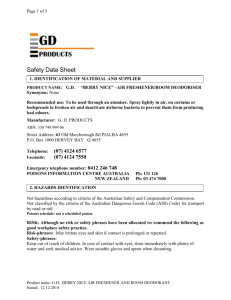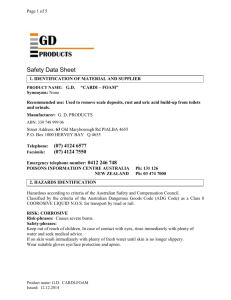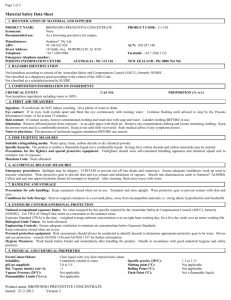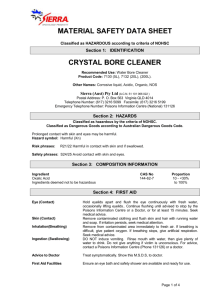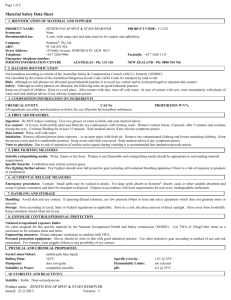GLEAM-MSDS-v2
advertisement
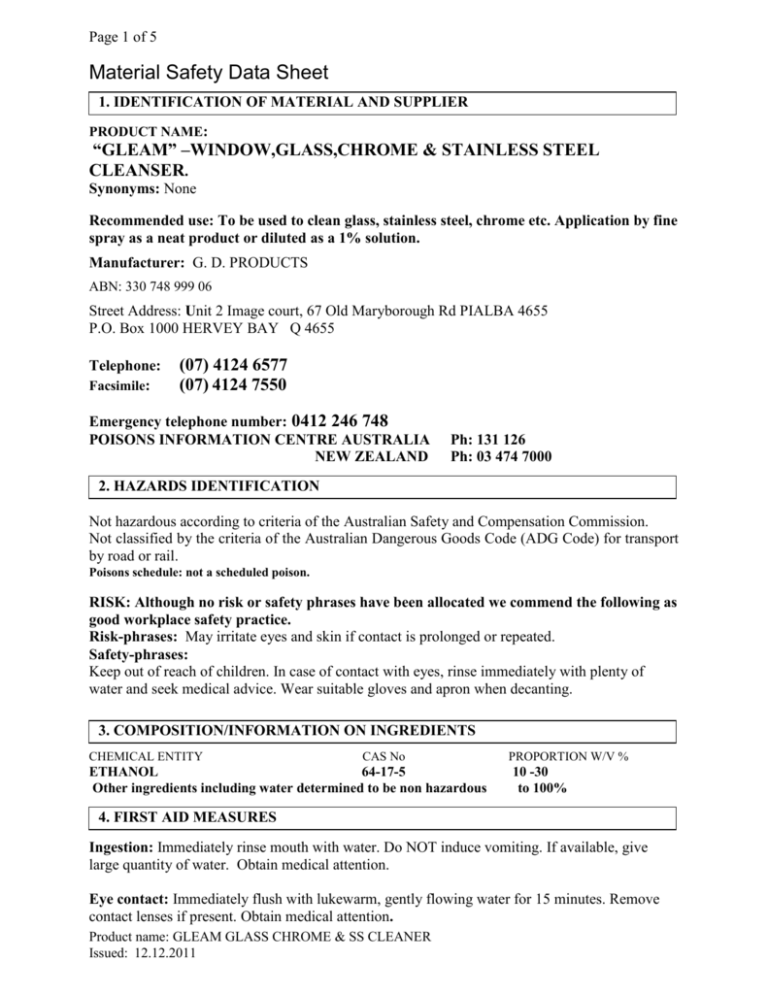
Page 1 of 5 Material Safety Data Sheet 1. IDENTIFICATION OF MATERIAL AND SUPPLIER PRODUCT NAME: “GLEAM” –WINDOW,GLASS,CHROME & STAINLESS STEEL CLEANSER. Synonyms: None Recommended use: To be used to clean glass, stainless steel, chrome etc. Application by fine spray as a neat product or diluted as a 1% solution. Manufacturer: G. D. PRODUCTS ABN: 330 748 999 06 Street Address: Unit 2 Image court, 67 Old Maryborough Rd PIALBA 4655 P.O. Box 1000 HERVEY BAY Q 4655 Telephone: Facsimile: (07) 4124 6577 (07) 4124 7550 Emergency telephone number: 0412 246 748 POISONS INFORMATION CENTRE AUSTRALIA NEW ZEALAND Ph: 131 126 Ph: 03 474 7000 2. HAZARDS IDENTIFICATION Not hazardous according to criteria of the Australian Safety and Compensation Commission. Not classified by the criteria of the Australian Dangerous Goods Code (ADG Code) for transport by road or rail. Poisons schedule: not a scheduled poison. RISK: Although no risk or safety phrases have been allocated we commend the following as good workplace safety practice. Risk-phrases: May irritate eyes and skin if contact is prolonged or repeated. Safety-phrases: Keep out of reach of children. In case of contact with eyes, rinse immediately with plenty of water and seek medical advice. Wear suitable gloves and apron when decanting. 3. COMPOSITION/INFORMATION ON INGREDIENTS CHEMICAL ENTITY CAS No ETHANOL 64-17-5 Other ingredients including water determined to be non hazardous PROPORTION W/V % 10 -30 to 100% 4. FIRST AID MEASURES Ingestion: Immediately rinse mouth with water. Do NOT induce vomiting. If available, give large quantity of water. Obtain medical attention. Eye contact: Immediately flush with lukewarm, gently flowing water for 15 minutes. Remove contact lenses if present. Obtain medical attention. Product name: GLEAM GLASS CHROME & SS CLEANER Issued: 12.12.2011 Page 2 of 5 Skin contact: Wash with soap and water until skin is no longer slippery. Obtain medical assistance if symptoms persist. Inhalation: If inhaled, remove from contaminated area. Give mouth-to-mouth resuscitation. Resuscitate in a well-ventilated area. Obtain medical attention immediately if there is difficulty in breathing. Notes to physician: Suggest intubation and gastric larvage if there are any adverse effects on the gastrointestinal system. If swallowed symptoms of inebriation may occur. 5. FIRE FIGHTING MEASURES Suitable extinguishing media: If material is involved in a major fire use water fog (or if unavailable fine water spray) to keep drums cool. Use foam, dry agent (carbon dioxide, dry chemical powder) to extinguish fires. Specific hazards: Small amounts of CO and CO2 may be generated in large fires. Wear suitable protective gear in this case. Emergency procedures: CONTAIN. Wear full protective gear to prevent skin contact. If small amounts absorb into diatomaceous earth, sand, earth. If larger amounts, contain liquid to prevent run off. Transfer to plastic containers using plastic scoops and funnels. 7. HANDLING AND STORAGE Precautions for safe handling: Wear water resistant clothing, boots and gloves with eye protection. Avoid skin and eye contact. Handle using good industrial hygiene practices. Wash contaminated clothing and washable equipment before storage or re-use. Storage: Store according to local, State or Federal regulations as applicable. Keep out of reach of children. Store in a cool, dry place and out of direct sunlight. Store away from foodstuffs. Keep containers closed when not in use. 8. EXPOSURE CONTROLS/PERSONAL PROTECTION National occupational exposure limits: No value assigned for this specific material by the National Occupational Health and Safety commission (NOHSC). Use TWA of 10 mg/Cubic metre as a maximum as for nuisance mists. As published by the National Health and Safety commission (NOHSC). Exposure Standard (TWA) is the time –weighted average airborne concentration over an eight hour working day, for a five day week over an entire working life. According to current knowledge these concentrations should neither impair the health of, nor cause undue discomfort to nearly all workers. Product name: GLEAM GLASS CHROME & SS CLEANER Issued: 12.12.2011 Page 3 of 5 These exposure standards are guides to be used in the control of occupational health hazards. All atmospheric contamination should be kept to as low a level as is workable. Exposure standards should not be used as fine dividing lines between safe and dangerous concentrations of chemicals. They are not a measure of relative toxicity Engineering measures: Control to below quoted Exposure Standards. Use with local exhaust ventilation. Keep containers closed when not in use. Do not smoke. Personal protection equipment: Avoid contact. Gloves and plastic apron if risk of splashes. Always wash hands before smoking, eating, drinking or using the toilet. Wash contaminated clothing and other protective equipment before storage or re-use. 9. PHYSICAL AND CHEMICAL PROPERTIES Form/Colour/Odour: liquid, pale blue with mild ammonia odour. Solubility: completely miscible with water. Specific gravity (20°C): 0.95 -0.98 pH as supplied @ 25ºC : 8 - 9. Melting point (C): < 0 Rel. Vapour density (air=1): N/D Flash Point (°C) Closed cup: not flammable Boiling Point (°C): approx 75 Vapour Pressure (20°C)mm Hg: N/D Decomposition Point (°C): >50 Use dilution pH 1% soln: 7.5 Flammability Limits (%): not applicable N/D = not determined. N/R =not relevant. 10. STABILITY AND REACTIVITY Stability: Does not polymerise. Keep containers in a cool dry place and closed when not in use to prevent loss of active constituents. 11. TOXICOLOGICAL INFORMATION No adverse effects expected if the product is handled in accordance with this Safety Data Sheet and the product label. Acute Effects: Ingestion: May irritate the digestive system. Eye contact: May irritate eyes. Skin contact: May cause irritation to skin. Prolonged or repeated contact may lead to contact dermatitis by defatting the skin. Inhalation: May cause irritation to the nose, throat and the respiratory tract. Long Term Effects: Poison Information Centres in each State capital city can provide additional assistance for Scheduled Poisons: Phone: Australia - 13 1126. Acute toxicity/Chronic toxicity: The major health hazard is defatting of the skin. LD50 (oral rat) not determined. Product name: GLEAM GLASS CHROME & SS CLEANER Issued: 12.12.2011 Page 4 of 5 12. ECOLOGICAL INFORMATION Ecotoxicity: Avoid release to the aquatic environment. May be fed to septic or sewerage systems. Persistence/Degradability: Not expected to be persistent in the natural environment. Surfactant/s present are biodegradable to Australian Standards. Mobility: Expected to be mobile in the aquatic environment. 13. DISPOSAL CONSIDERATIONS Disposal methods: Large empty containers should be forwarded to an approved agent for recycling. Small containers should be tripple rinsed and sent to recycling or local waste disposal. Refer to State/Territory Land Waste Management Authority if in doubt. 14. TRANSPORTATION INFORMATION Not classified by the criteria of the Australian Dangerous Goods Code (ADG Code) for transport by road or rail. UN No: not applicable. Proper Shipping Name: not applicable. Segregation Dangerous Goods: no special requirements. 15. REGULATORY INFORMATION Poisons Schedule: Not a scheduled poison. All of the constituents of this material are listed in the Australian Inventory of Chemical Substances. UN No: Not applicable. Proper Shipping Name: Not applicable. 16. OTHER INFORMATION Literary reference: Approved Criteria for Classifying Hazardous substances [NOHSC:1008(1999)] and HSIS. Australian Code for the preparation of Material Safety Data Sheets 2003 National Exposure Standards [NOHSC:1003(1995)] List of designated hazardous substances and HSIS [NOHSC:10005(1999)]. Standard for the Uniform Scheduling of Drugs and Poisons. The Australian Code for the Transport of Dangerous Goods by Road and Rail. Reason(s) For Issue – update of version 17th August 2004. This MSDS summarises at the date of issue our best knowledge of the health and safety hazard information of the product: and in particular how to safely handle and use the product in the workplace. Since G.D. PRODUCTS cannot anticipate or control the conditions under which the product may be used, each user must, prior to usage, review this MSDS in the context of how the user intends to handle and use the product in the workplace i.e. a risk analysis. If clarification or further information is needed to ensure that an appropriate assessment can be made, the user should contact G.D. PRODUCTS. Product name: GLEAM GLASS CHROME & SS CLEANER Issued: 12.12.2011
